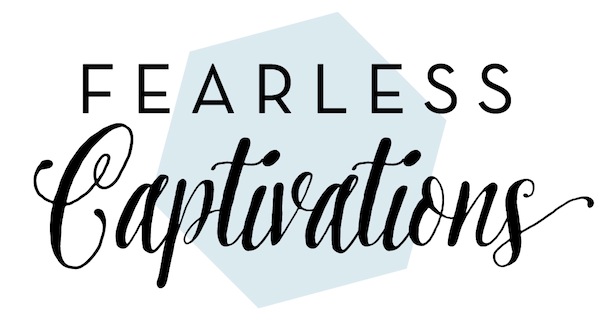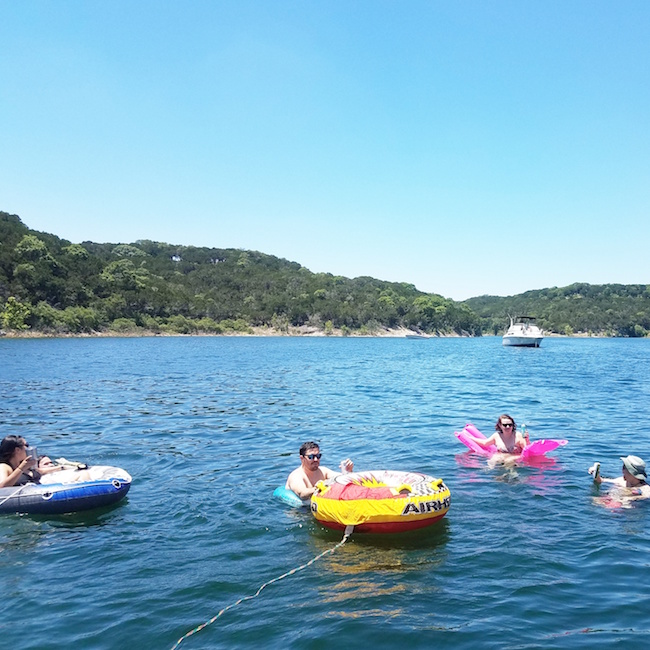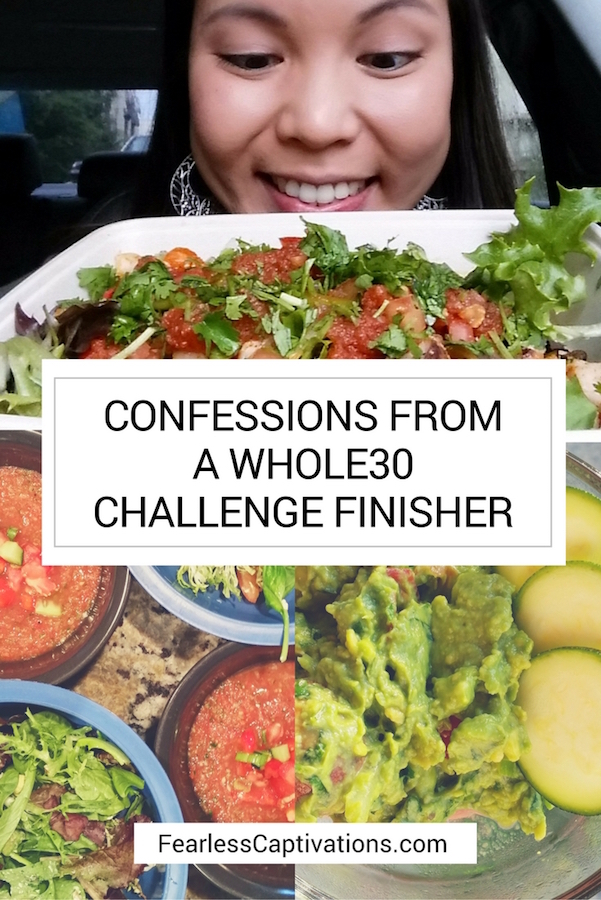
I did it! Thirty days of the Whole30 Challenge! I survived a month of no added sugar and grains and cake! It got rough in the middle of the month and I almost quit but the finisher in me said not today! I took notes before, during and after the program and would love to share all the details with you.
Please note: this post is all about my personal experience doing Whole30. Whole30 is not for everyone and I recommend you doing your own research and/or consulting your doctor/nutritionist to know if it will benefit you.
What is the Whole30 Program?
The Whole30 Program focuses on changing your relationship with food.
- You focus on eating whole, non-processed meats, fruits and vegetables and removing added sugar (in any form, including honey), alcohol, grains, dairy, soy and legumes from your diet.
- People who participate have found it helps with gut issues, hormonal imbalance, and inflammation, offering better skin, improved metabolism and more energy. Of course, results vary.
- Also, recreating recipes using approved ingredients is not recommended because it doesn’t change the way you think about food. You can read more about that here.
- Compared to other eating programs (paleo, keto, etc.), Whole30 is meant to be a short-term reset.
My Diet Before Whole30
My diet was relatively mindful before doing Whole30. Meals with my boyfriend usually involved home-cooked meat (usually lamb and beef) and vegetables, very little processed foods, and usually no gluten products like pasta and bread. Lunch is my weakness because our work cafeteria has plenty of hearty, carb-heavy foods, and desserts. This is where I get a lot of my pasta and cake, though I do try to stay away.
Why did I do Whole30?
The big reason we did Whole30 was to experiment. I saw a few people in my network had recently finished the Whole30 program, so I did some research about what it involved and the benefits. Talking with my boyfriend, we agreed it seemed “easy” enough to adjust our diet, so we jumped in. I’ve never had specific food restrictions (diet) before, I don’t have food allergies or health issues and I’m ok with my weight.
I specifically did Whole30:
- To analyze my mental relationship with food. Am I eating to eat or because I’m hungry? Can I maintain my self-control? How much do I crave dessert and how much of it is mental?
- To analyze my physical relationship with food. Does my body work more efficiently if I don’t eat particular foods? Will my skin have a different appearance by eliminating certain foods? Will I have sugar and carb cravings?
- For the sake of curiosity. Will I feel more energized? Will I lose weight?
- To cleanse my body. Not consuming any processed foods and added sugar will mix up the systems in my body.
- To gain a greater appreciation for the abundance of options for food I have in my life and for my healthy body to be able to enjoy and process that abundance. I eat whatever I want and don’t have any food allergies. That can’t be said of people with a different level of wealth, limited access to ingredients, or with food allergies or health issues.
What Did I Eat/Drink During Whole30?
We aimed for everything to be organic, grass-fed, and natural. We ate a handful of the same meals (like steak, roasted vegetables, and salad) but also tried Whole30 recipes we found. Overall, I did not go hungry and there were plenty of recipes and ingredients we could eat. Check out this post for all my favorite Whole30 recipes and more info on what we ate.
Lessons Learned and Observations During Whole30
- No surprise, the food I missed and craved the most was cake. Runner-ups included cookies, breakfast tacos, beer, and cheese. The cravings were very mental. Telling myself I couldn’t have it made me want it more. By week three, the cravings weren’t so bad.
- You really need to pay attention! This is where I tell you that on day 7, I absent-mindedly ate a spring roll with rice noodles in it and had to start all over the next day.
- My work has a buffet every day and most of the options are not Whole30-approved. Seeing these carb- (pasta, sandwiches) and sugar-filled (desserts) options daily was a struggle! Some days after lunch, the sugar cravings were mind-boggling. There were many, many days I craved cake. By week three I was doing a lot better with the cravings.
- I stopped eating out. Knowing that variations of sugar and non-compliant ingredients are added to most dishes and sauces made me wary of eating out. I didn’t want to be that customer questioning every ingredient in a dish. I also didn’t want to be tempted or feel sad about menu items I couldn’t enjoy.
- In exploring what I could and couldn’t have, I read more labels than usual. It’s interesting to see ingredients I couldn’t pronounce or don’t think belonged on a label. Sugar is in most products! While some were not necessarily “bad,” I wonder how eating more products that are as natural and organic as possible could be life-changing. Plus, sugar adds calories! For example, in the photo below, there is a sea of pasta sauces at the grocery store, and only two kinds were compliant. All the other ones had added sugar.
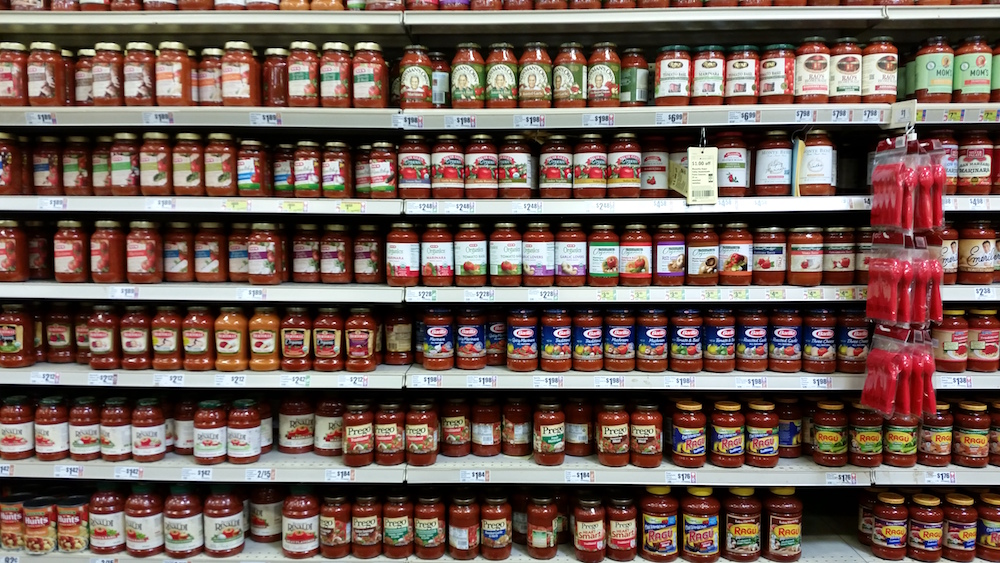
- Eating out is what I like to do with friends, so I wasn’t very social during Whole30. There were also a handful of events I had to say no to because they were centered around trying food or drinks. You bet I have a long list of new restaurants to go try!
- Meal prep takes time. We were taking breakfast, lunch, and snacks to work every day. We cooked every meal from scratch. We usually make dinner every night but we also had to do it on the weekends. Thankfully, the slow cooker helped lessen the prep but the addition of preparing extra meals was time-consuming. We also had to continuously find new recipes to mix it up.
- I felt weak and tired during my workouts and some days after work. During workouts, my body got tired quickly and while I could do the workout, I didn’t feel like I had full energy. After the workout, I felt completely exhausted. My strength improved by weeks three and four.
- I felt more energized overall. Getting out of bed wasn’t as much of a struggle, despite bad sleep. I felt alert throughout the day and didn’t feel an afternoon slump after lunch.
- My metabolism and digestion system were superbly efficient. So efficient that my bladder woke me up in the middle of the night every night the first two weeks. Not cool. But faster digestion meant I never felt bloated, except when we ate mashed potatoes one meal. I think the efficiency allowed my face to be blemish-free throughout the 30 days.
- I had been working out for two months, three to four workouts a week, prior to starting Whole30 and I saw no change in my weight. (Yay, muscle?) I kept the same number of workouts and after Whole30, I had lost six lbs. and gained more muscle.
- If you do Whole30, expect weeks one and two to be awful. You’ll feel physical and mentally rough (ranging from tired, antsy, and maybe actual pain) and you won’t be enthused about your food options. By weeks three and four, you’ll hopefully feel better and excited about the home stretch.
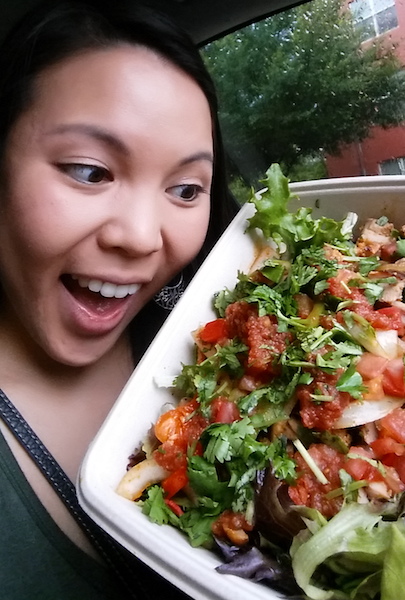
I was nervous to eat out but in the last weekend I found Freebirds’ list of ingredients on their website and got a compliant salad!
Conclusion
Overall, I didn’t see life-changing, earth-shattering results from doing Whole30, possibly because my eating habits weren’t out-of-hand before and it’s hard to judge results in only 30 days. I could very well take back that statement when I start adding in foods I haven’t been eating!
The big thing I took from doing Whole30 is that there are many options for food and some are better for you than others. Fresh, organic produce is always better. Organic fruit tastes a million times better. A lot about eating and cravings is mental. Eat things you love. Moderation is key. Educate yourself. Make better choices.
Did I enjoy doing Whole30? Kind of. Was it hard? At times. Would I do it again? Yes/Maybe. Was it a worthwhile experiment? Yes! Is this really what I ate the morning after Whole30 ended? Yes.
If you have any questions about my Whole30 experience, please leave me a comment below!
Have you done Whole30? Tell me about your experience!
